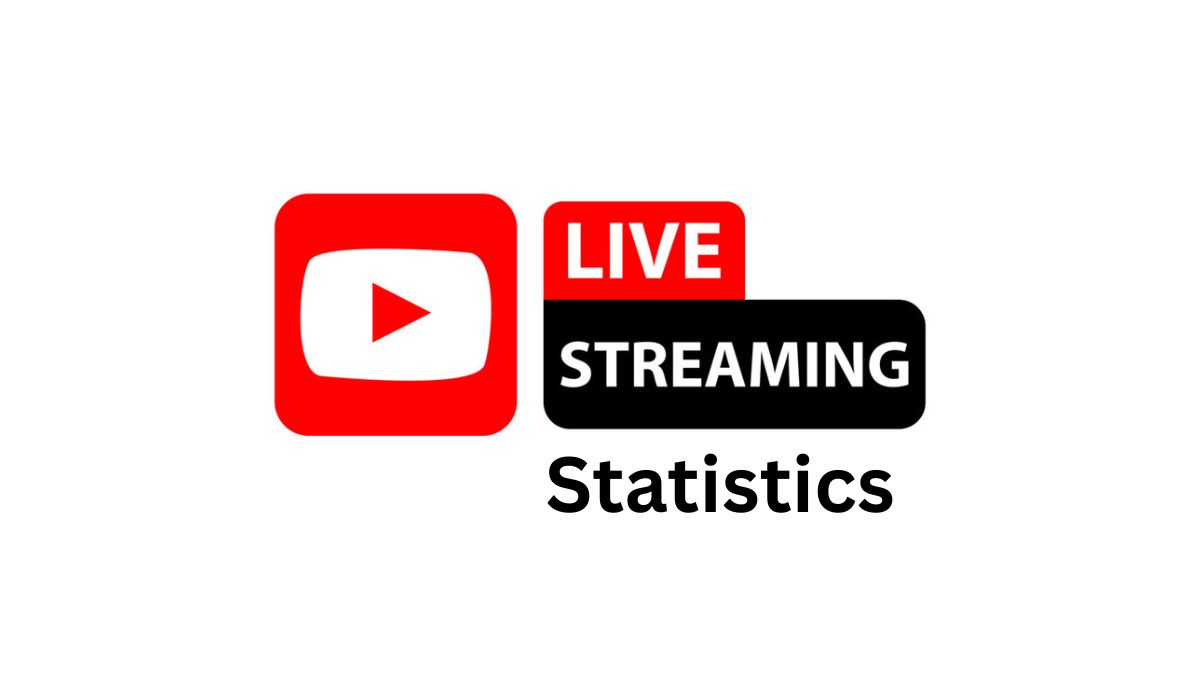Udemy Statistics And Facts (2025)
Updated · Apr 10, 2025

Table of Contents
- Introduction
- Editor’s Choice
- Financial Highlights
- Business And Operational Highlights
- Number Of Udemy Learners
- Number Of Udemy Courses
- Udemy B2B And B2C Revenue
- Percentage Udemy Business Revenue Contribution
- Number Of Udemy Instructors
- Udemy Net Income
- Udemy Employee Count
- Udemy Category Wise Revenue
- Conclusion
Introduction
Udemy Statistics: Having launched in the year 2010, Udemy has grown to be a foremost online learning platform, offering a great variety of courses to audiences across the globe. It connects learners with instructors and, therefore, assists in skill development in many areas.
A noteworthy financial and operational development was noted in 2024 for Udemy, which illustrates its changing business strategy and positioning in the marketplace. This article discusses the key highlights of Udemy statistics.
Editor’s Choice
- In 2024, Udemy’s total revenue was up 8% from the prior year to US$786.6 million; foreign exchange rate fluctuations had a negative influence on this.
- Udemy statistics state that in the Enterprise section, Udemy Business earned US$494.5 million, an 18% increase over the previous year, while Consumer revenue was down by 5% to US$292.1 million.
- Udemy Business’s Annual Recurring Revenue (ARR) rose 11% to US$516.9 million.
- At the end of 2024, Udemy had US$355.7 million in cash, cash equivalents, restricted cash, and marketable securities.
- In 2024, Udemy attracted an additional eight million learners, bringing its total learner base to 77 million, on top of nearly 1,400 new enterprise customers.
- In keeping with a strong commitment to creating shareholder value, Udemy also completed a US$150 million share repurchase program.
- Udemy statistics show that Udemy’s AI-driven Skills Mapping capability has been employed by more than 1,800 enterprise customers, with more than a third of learning paths created through this capability.
- In North America, Amazon Web Services has named Udemy as 2024’s Rising Star Partner of the Year.
- From 40 million Udemy learners in 2019, there were 75 million learners by early 2024, confirming a consistent growth trend.
- From an initial 130,000 courses in 2019, the current course catalog will comprise about 250,000 offerings by 2024.
- The growth of the business-to-business (B2B) segment, representing US$120.6 million in 2024, has greatly outpaced that of the Consumer (B2C), which generated only US$73.8 million.
- Layoffs in 2023 and 2024 were implemented to save US$30-32 million per year; however, company stock nevertheless dropped by 46% in 2024.
- Management attributed its first-ever quarter-over-quarter revenue decline to sector-specific influences that saw Consumer revenues drop to US$73.8 million in Q2 2024 from US$79.2 million in the previous quarter.
- Udemy statistics reveal that in 2024, Udemy Business contributed 60% of the total revenue compared to 18% in 2019 and expects to contribute 75% moving forward.
- If instructor growth continued at this pace, Udemy would still be adding about 1,500 instructors per year, which, until recently, had grown from 50,000 instructors in 2019 to 75,000 in 2024.
- Due to cost-cutting measures, Udemy’s losses peaked at US$153.8 million in 2022 and improved to US$75.4 million by 2024.
- The number of employees had been changed from year to year, peaking in 2022 with 1,678 and falling again to 1,443 in 2023 due to layoffs.
- With 90% of Udemy courses not contributing 75% of total platform revenue, it is hard for most courses to achieve financial success.
Financial Highlights

(Source: investors.udemy.com)
- According to Udemy statistics, Udemy in 2024 Stacks up 8% YoY Revenue – US$786.6 million housings. However, this growth suffered around a negative decline of 2 percentage points as a result of a loss in foreign exchange (FX) rates.
- The Enterprise segment, hence known as Udemy Business, has provided revenues of US$494.5 million – which is ghastly close to the general increase of around 18% year-on-year.
- Similar to overall revenue, growth in Udemy does face a negative impact of 2 percentage points from FX rate changes.
- The platform’s annual recurrences amount has jumped by 11% year on year to US$516.9 million.
- On the other side lies the marking down of the Consumer segment with the drop in annual revenues by 5% to US$292.1 million, suffering similar deep losses from FX of 2 percentage points.
- At the end of the reporting period, Udemy would have a cash balance of US$355.7 million in cash, cash equivalents, restricted cash, and marketable securities.
- For the fourth quarter of the year 2024, Udemy will have revenues in total of US$199.9 million, reflecting a 5% growth compared with the same period last year. This growth also includes a 2-percentage-point hit from changing FX rates.
- Udemy Business was no exception to the flourishing of the revenue, ending the quarter at US$130.1 million, up by 13% compared to the same period a year ago, although FX rate fluctuations took their effect on the growth, bringing it down by 2 percentage points.
- The Consumer segment recorded opposite turns as revenue dipped by 7% year-over-year, down to US$69.8 million, incurring the same 2 percentage points negative impact from FX rates.
Business And Operational Highlights
- As for Udemy statistics, it had a tremendous growth opportunity in the year 2024, with 8 million new learners signing up and closing almost 1,400 new Enterprise accounts.
- By the year’s end, Udemy had reported 77 million learners and 17,096 Enterprise accounts.
- Udemy created some new or advanced relationships with major corporate clients to influence its global reach.
- Some of the major companies that Udemy Business brought into or expanded with over the 12 months were Akbank in Turkey, Analog Devices and Dropbox in the U.S., and Arm in the U.K.
- From the U.S., Atlas, E.ON in Germany, Grupo Bancolombia, Innovaccer Analytics Private Limited in India, Itaú Unibanco in Brazil, Kellanova/Kellogg Company in the U.K., Krungthai Bank in Thailand, Nasdaq in the U.S., and Navin Fluorine International Limited in India have also been established.
- It completely shows that Udemy has an intense belief in the long-haul strategy along the lines of creating shareholder value through the US$150 million share repurchase program being fully completed during the year.
- Besides this, Mexico City, Mexico, was the latest to open up. This was done to further scale the operations in the LATAM market while enhancing the delivery of personalised high-level learning experiences to align with the rapidly changing organisational and professional demands in the area.
- Udemy further cooperated with Ingram Micro to enhance offerings, benefiting upskilling opportunities and customer experiences. This partnership enabled Udemy Business products and solutions to be made more widely available through Ingram Micro’s India distribution channel.
- AI-driven learning gained a lot of traction, with over 1,800 Enterprise customers using Udemy’s Skills Mapping feature since its launch in November 2024.
- More than one-third of the learning paths created by these customers were built on this AI-driven feature, demonstrating nonetheless the effectiveness in personalisation capability for skill development.
- An array of accomplishments led to Amazon Web Services designating Udemy its 2024 Rising Star Partner of the Year in North America.
- During that period, Udemy also strengthened its leadership with the appointment of two new independent directors to its Board: Marylou Maco, Chief Revenue and Customer Experience Officer, Avaya, and Debra Chrapaty, Chief Technology Officer, Toast, thus furthering strategic leadership development and supporting Udemy in its preferred growth path in the global e-learning marketplace.
Number Of Udemy Learners
| Year |
Number of Udemy learners
|
| 2019 |
40 million
|
| 2020 |
44 million
|
| 2021 |
49 million
|
| 2022 |
59 million
|
| 2023 |
67 million
|
| 2024 |
75 million
|
(Source: grabon.in)
- Udemy statistics show that Udemy’s learner base has grown steadily over the last six years. In 2019, there were 40 million learners on the platform; in 2020, that figure rose to 44 million.
- Growth in 2021 was at an accelerated pace, with a total of 49 million learners. This was followed by an impressive spike to 59 million learners in 2022.
- By 2023, it had grown to 67 million learners, and 2024 marked another significant milestone for Udemy- with 75 million learners. This steady rise indicates Udemy’s efficiency at gaining new users and retaining current users.
- This has been possible through its wide course categories, developing enterprise partnerships, and constant enhancement of learning technologies.
- The continuous increase in learners indicates the increasing demand for online education and professional upskilling, which positions Udemy among the first e-learning platforms globally.
Number Of Udemy Courses
| Year |
Number of Courses
|
| 2019 | 130,000 |
| 2020 | 183,000 |
| 2021 | 185,000 |
| 2022 | 213,000 |
| 2023 | 210,000 |
| 2024 | 250,000 |
(Source: grabon.in)
- Over the years, Udemy has slowly gained more courses, signaling its intent to provide diversity and relevancy in its educational content.
- Udemy had been offering 130,000 courses in 2019, with the added courses becoming 183,000 in 2020, possibly due to an overwhelming demand for online learning during the COVID-19 pandemic.
- There was low growth into 2021, with 185,000 courses being offered. The ramp-up furthered in 2022 when 213,000 courses were offered on the platform.
- In 2023, a decrease occurred to 210,000 courses, perhaps relating to content optimization and removal of outdated courses being implemented, which might have coincidentally affected the decisions made by Udemy possibly toward prioritizing quality over quantity.
- Udemy statistics indicate that in 2024, nevertheless, Udemy saw large expansions having courses offered reach a historical peak of 250,000. This sudden ramp-up shows a strong inflow of new content, probably owing to the advancement of AI tools for course creation, the much bigger pool of instructors, and the strengthening outreach of the platform.
Udemy B2B And B2C Revenue
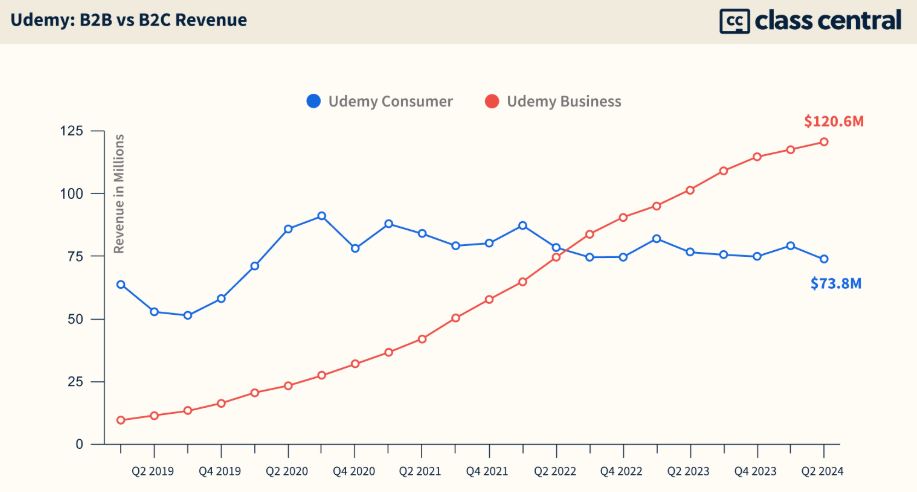
(Source: classcentral.com)
- According to Udemy statistics, Udemy’s revenue in the past years has seen a great boost in its revenue from both Consumer (B2C) and Business (B2B) segments. In 2019, while the Consumer segment contributed US$19 million, the Business segment brought in US$56 million.
- By 2024, Consumer revenue had risen to US$73.8 million, steady growth still going on in individual course purchases despite recent downfalls.
- A much steeper upturn has been enjoyed by the Business segment, which provides learning solutions to companies and organizations.
- By 2024, Udemy Business revenue will amount to US$120.6 million, doubling the revenue in 2019. This spearheading growth focuses on the company’s interest in enterprise learning, where the stability of corporate clients gives more sustained and recurring revenue than the unstable nature of individual course buyers.
- While the Consumer segment still underwent some concerning downtimes, Udemy’s Business segment appears increasingly appealing for the growth and sustainability of the company.
- Udemy statistics state that in February 2023, Udemy implemented a layoff expected to result in annual savings of about US$30–32 million, resulting from about 200 job cuts.
- A similar round of workforce reduction was made in 2024, with some positions expected to be moved to cheaper areas.
- Notwithstanding this being seen as a pragmatic move financially, subsequent to this, Udemy saw a 20% fall in stock price, which has contributed to an overall 46% downturn in 2024.
- The financial setback has troubled Udemy, especially in Q2 of 2024. The revenue figure for Udemy for Q2 was US$194.4 million, which was the first instance when it recorded a drop in revenue quarter-over-quarter.
- This was largely due to a fall in consumer revenue, where it slipped from US$79.2 million in Q1 to US$73.8 million in Q2.
- This segment is hovering around the pre-COVID levels, indicating a dramatic change in online learning demand among individual learners. This scenario of Udemy struggling with consumer revenue and the other side sees Coursera having challenges in growing its business segment.
- The major difference between the two platforms arises mostly from their business models-Udemy focuses more on offering a vast library of content, while Coursera emphasises credentials and accredited programs.
- The latest valuation shows Udemy’s prevailing market capitalisation of US$1.11 billion, a valuation that has decidedly been affected by its financial difficulties and market changes.
Percentage Udemy Business Revenue Contribution
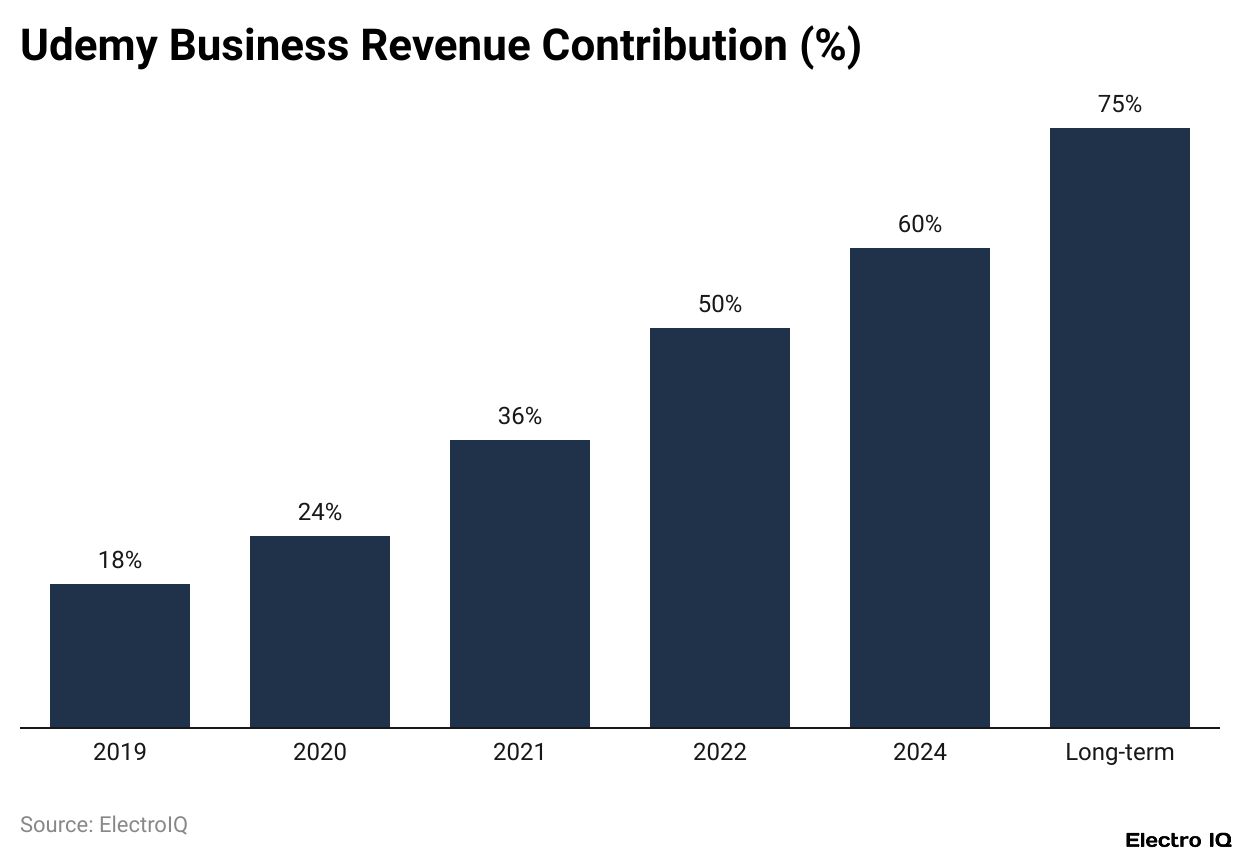
(Reference: sellcoursesonline.com)
- Udemy has now become an integrated enterprise learning solution for the growing corporate market, thereby contributing increasingly to overall revenue.
- In 2019, Udemy Business contributed only 18% of total revenues; this increased rapidly to 24% in 2020 as organisations moved toward online training. In a remarkable turn of events, this contribution increased to 36% in 2021, showing early traction within the corporate training market.
- The momentum continued in 2022, where Udemy Business gained ground and captured 50% of total revenue, where for the first time, it equaled consumer revenue.
- Udemy statistics reveal that in 2024, it has increased to 60%, showing an ever-growing reliance of the company on enterprise clients. In the future, Udemy will actively work to push these numbers up further, with a long-term target of 75% of total revenue coming from Udemy Business.
- On the financial side, Udemy Business represented US$56 million in revenue in the last quarter and reported US$120.6 million in annual revenue, thereby confirming its position as the main growth engine of the company. This shift is in itself another step in Udemy’s focus on large-scale enterprises, creating revenue stability and decreased dependency on the more volatile consumer segment.
Number Of Udemy Instructors
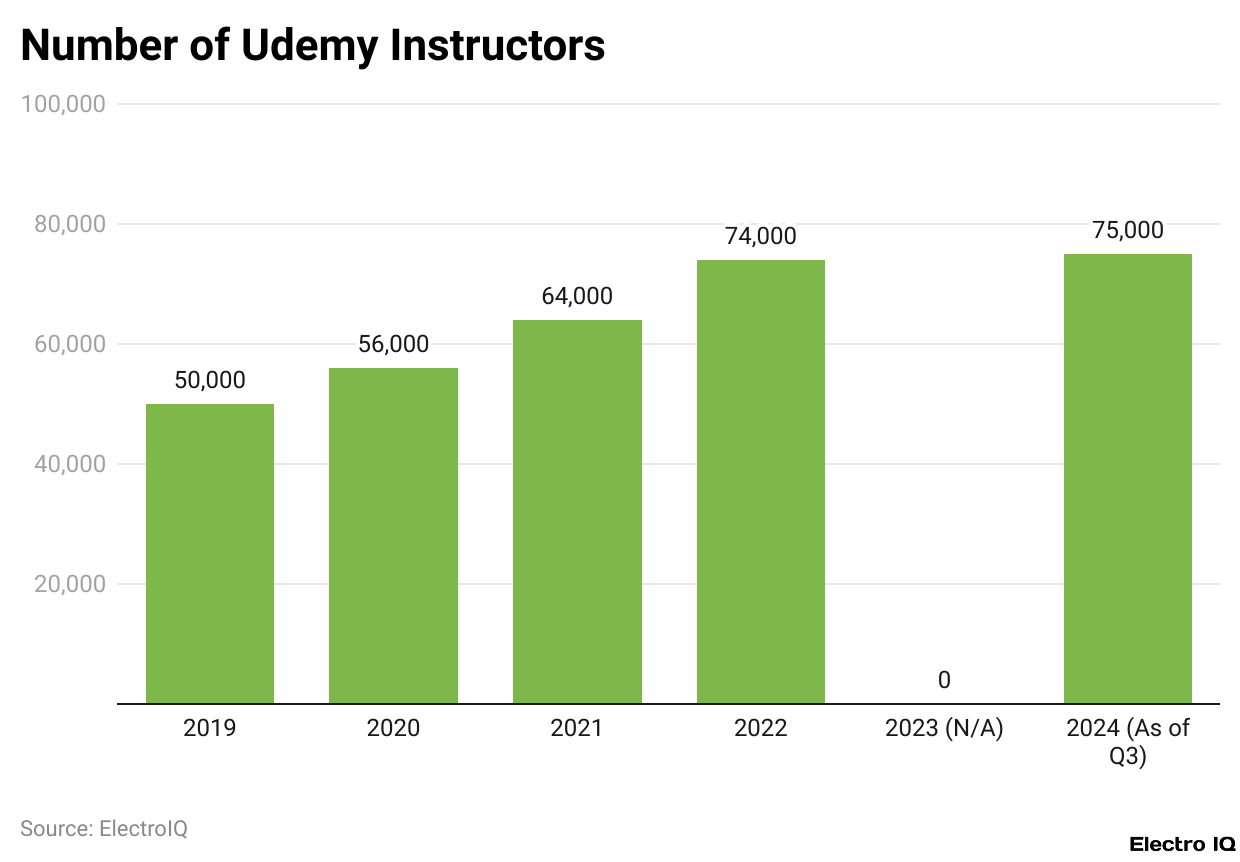
(Reference: grabon.in)
- Instructor growth at Udemy has been steadily on the rise over the years, reflecting the widening reach and appeal of the platform to educators.
- In 2019, the number of instructors stood at 50,000. This figure grew to 56,000 in 2020, possibly fueled by the immediate demand for online education due to COVID-19. The growth curve continued in 2021, with an increase reaching 64,000 instructors as educators and professionals sought to share their knowledge through digital courses.
- By 2022, Udemy was endowed with a staggering 74,000 instructors, a very noticeable jump as the platform continued to attract a plethora of content creators.
- The number of instructors, however, has shown constrained growth post-2022, with an insignificant increase to 75,000 in 2024.
- It is possible that slower growth reflects Udemy’s shift toward a strategy emphasising course quality over quantity in terms of instructor offerings, a stabilisation in new instructor enrollments, or increasing competition in the online education market.
Udemy Net Income
| Year |
Net Income
|
| 2019 |
– $70 million
|
| 2020 |
– $78 million
|
| 2021 |
– $80 million
|
| 2022 |
– $153.8 million
|
| 2023 |
– $107.3 million
|
| 2024 |
– $75.4 million
|
(Source: grabon.in)
- Over the years, Udemy has experienced net loss year on year; the losses, however, have varied in extent.
- In 2019, for instance, such net loss was recorded at US$70 million; in 2020, it was at US$78 million. The loss further widened for 2021 and recorded US$80 million, revealing that Udemy was still in the process of investing in growth and expansion.
- The greatest jump was seen in 2022 when it reached US$153.8 million, the highest in its history. This was brought on by increased costs and expenditures related to further developing the platform in addition to market alterations brought about by the pandemic.
- Udemy statistics show that the loss was further reduced by the company in 2023 to US$107.3 million, thus signifying that there is an attempt towards cost-cutting as well as improving efficiency. In 2024, Udemy’s net loss further decreased to US$75.4 million, representing a significant positive change.
- The indications reveal that the company’s cost-cutting measures through layoffs and restructuring have shown a good outcome.
- Although Udemy has not made a profit, the figures for 2023 and 2024 indicate that it is indeed on the road toward some financial stability.
Udemy Employee Count
| Year |
Number of Employees
|
| 2018 | 1,100 |
| 2019 | 1,238 |
| 2020 | 1,500 |
| 2021 | 1,238 |
| 2022 | 1,678 |
| 2023 | 1,443 |
(Source: grabon.in)
- According to Udemy statistics, Udemy’s workforce size has fluctuated over the years and is indicative of the company’s expansion and restructuring phases. In 2018, the company recorded 1,100 employees and edged past that number to 1,238 in 2019.
- There was a big jump during 2020 with the highest 1,500 employees, most likely due to the online learning provisions mandated by the COVID-19 pandemic.
- That was short-lived, as by 2021, the number dropped back to 1,238 once again owing to what seems to be a readjustment of the workforce or streamlining of operations.
- By 2022, Udemy expanded once again, with a burgeoning 1,678 employees, the most in Udemy’s history. The jump was perhaps in line with the company’s promise in enterprise solutions with more focus on global expansion.
- Unfortunately, by 2023, it had to shrink to 1,443 as part of layoffs ushered in to cut down costs and improve efficiency. This would characterise the metamorphosis scenario of Udemy, striking a fine balance between growth and financial sustainability.
Udemy Category Wise Revenue
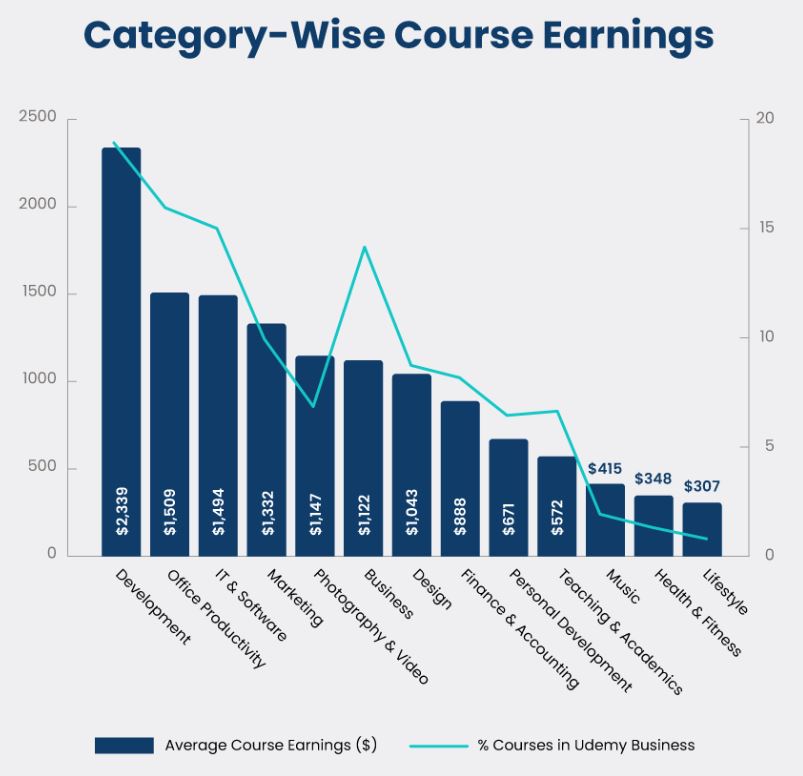
(Source: sellcoursesonline.com)
- An overwhelming majority of Udemy courses hardly make good money. Data show that 90% of the courses are not in the business of contributing to the 75% of the revenues of the entire platform. There should be a very thin line between most courses and financial success.
- A significant gap between courses is the inclusion of the course in Udemy Business. In high-demand topics like Development and IT & Software, about 19% and 15% of total courses, respectively, are included in Udemy Business.
- At the other end of the spectrum, Music, Health and Fitness, and Lifestyle courses range from a meager 1% to 2%. This is expected given the fact that business clients focus on developing skills in technology and software areas and not personal hobbies or fitness.
- However, this compromises the average earnings by category. Development courses make an average of US$2,339 while IT & Software courses average at a total of around US$1,494.
- Meanwhile, Music Health & Fitness and Lifestyle courses make significantly less on average, about US$350. This shows the financial advantage of taking topics in business-relevant courses over more niche or personal interests.
Conclusion
As per Udemy statistics, Udemy demonstrated significant progress in terms of the enterprise segment, suggesting that the strategic focus on larger organisations is indeed effective. While the consumer segment appears to have some issues, the company is well-positioned for growth in the future as a result of the AI push, global expansions, and more partnerships.
Improvements in the key financial matrices give weight to Udemy’s commitment to operational efficiency and the possibility of profitability in the following years.
Sources
FAQ.
Udemy’s revenue during the year was US$786.6 million, representing an 8% growth over the previous year. Furthermore, this growth was adversely affected by foreign exchange fluctuating rates, which accounted for two percentage points of declined growth. While the revenue earned through Udemy Business grew by 18% to US$494.5 million, Consumer revenues shrank by 5% to US$292.1 million. Despite the cost reductions evident in the overall stock price, it dropped 46% for the year.
In 2024, 60% of total revenue comprises Udemy Business realisation, which was just an 18% share in 2019. Hence, this segment contributed a revenue of US$494.5 million, and its Annual Recurring Revenue (ARR) grew at about 11%, leading to a total of US$516.9 million. Udemy plans to increase this share to 75% in the future.
By the end of 2024, Udemy had 77 million learners, having grown from 40 million in 2019. The course catalog also grew significantly to 250,000 courses from 130,000 in 2019. This growth reflects the growing number of overseas students that will enroll for online education given the continuing demand for education delivered online.
There were layoffs in Udemy in both 2023 and 2024, each valuing between US$30-US$32 million in savings. From 1,678 at the highest peak in 2022, the number of employees fell to 1,443 in 2023. While the company has managed to cut costs, Udemy’s stock has fallen 46% this year, which is partly attributed to the bad performance of the Consumer segment.
Development and IT & Software prove to be the most lucrative course categories, with an average earning of US$2,339 and US$1,494, respectively. In comparison, Music, Health & Fitness, and Lifestyle earn substantially less – US$350. Additionally, of all the courses on Udemy, only 10% contribute up to 75% of the entire earnings of the platform, making financial success very difficult for most of the instructors.

Barry Elad is a passionate technology and finance journalist who loves diving deep into various technology and finance topics. He gathers important statistics and facts to help others understand the tech and finance world better. With a keen interest in software, Barry writes about its benefits and how it can improve our daily lives. In his spare time, he enjoys experimenting with healthy recipes, practicing yoga, meditating, or taking nature walks with his child. Barry’s goal is to make complex tech and finance information easy and accessible for everyone.

